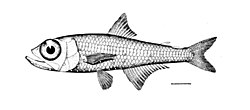| Benoit's lanternfish | |
|---|---|
 | |
| Scientific classification | |
| Kingdom: | Animalia |
| Phylum: | Chordata |
| Class: | Actinopterygii |
| Order: | Myctophiformes |
| Family: | Myctophidae |
| Genus: | Hygophum |
| Species: | H. benoiti |
| Binomial name | |
| Hygophum benoiti Cocco, 1838 | |
The Benoit's lanternfish (Hygophum benoiti) is a species of widespread oceanodromous lanternfish. [1]
